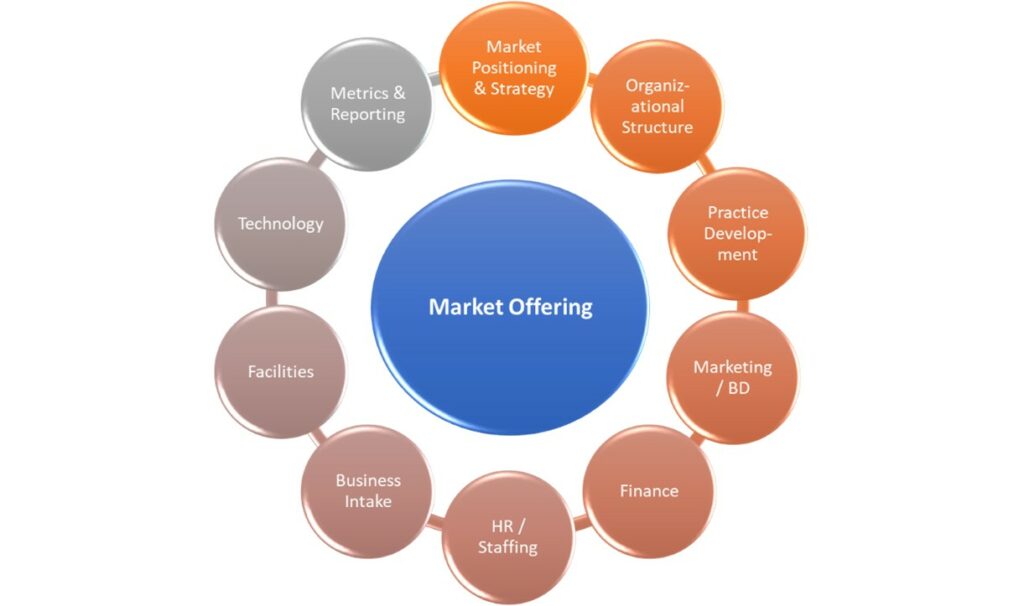By: Mike Lowe, Unbiased Consulting
Introduction
In July a few years ago, on a roof deck overlooking the National Mall, at an event headlined by Senators from both parties, a large global firm launched its Strategic Communications team. The latest of several non-legal market offerings, the Strategic Communications initiative positioned the firm to more fully serve the needs of its clients while capturing revenue that had previously been spent elsewhere. Unbeknownst to most attendees enjoying finger food and casually networking, this launch was the culmination of months of strategy, planning, organization, and collaboration. It represented the triumph of innovation over the forces of inertia and risk aversion. How did we get to this point while avoiding the many pitfalls experienced by firms attempting to innovate by stepping outside of their traditional legal practice areas?
The Opportunity

When I consulted with a global hotel chain years ago, we sought to maximize “share of wallet” – the percentage of a customer’s vacation dollar that was spent at their property. The same concept applies to law firms and their clients. They occupy a position that other professional services would kill for – possessing trusted relationships with clients who come to them precisely at their time of need. They understand their clients’ business needs and priorities, and they have a relationship of privilege that protects many of their interactions.
Firms have grown tired of referring non-legal work to other professional services firms, simultaneously losing revenue and ceding control over the ultimate outcome for the client. It is rare that client needs are addressed fully by legal services. Perhaps they have had a cyber breach and need help addressing technical vulnerabilities. Perhaps they are developing financial products and seek consulting on how to generate a regulatory compliance program. Or, perhaps they want to launch a communications campaign associated with a proposed merger under government review. In all these instances, who is better positioned to understand and serve the client than their law firm?
The Challenge
Successfully developing a non-legal offering is much harder than just identifying the market opportunity. The legal world is rife with failed attempts at expanding services outside of legal. The many challenges that firms encounter when developing a new offering include:
- Developing a bold vision – offerings frequently begin as modest, low-risk, incremental additions of one or two people. Those can provide incremental revenue but fail to seize the true opportunity and rarely endure.
- Understanding of the market, the buyers, and buyer values – the person at the client responsible for procuring your non-legal service may not be the same person with whom you have a relationship, and your law firm brand may not carry the same cachet with non-legal buyers.
- Staying price competitive with non-legal, lower-overhead competitors – it is likely that your non-legal competitors are not located in the city’s finest office buildings with subsidized cafeterias and coffee bars. Can you justify charging a premium to cover your overhead?
- Choosing the right operating model – there are different options for sourcing parts of or all of the services you provide – referrals, outsourcing, in-sourcing. Ultimately, the model needs to support your long-term vision, not just short-term expediency.
- Attracting and retaining talent – you want your non-legal professionals to be world-class like your lawyers. Top talent will not be attracted to a job with no clear career path and a sense that they will be second-class citizens.
- Deploying and motivating your sales force (i.e. the Partners) – client relationships are owned by the Partners, who may not know about your services, or know how to sell them.
- Understanding the full scope of planning and decision making – firms underestimate the amount of planning, coordination and communication required to develop and embed a new offering. If it was easy, everyone would do it!
The Blueprint
While helping firms develop and launch a range of non-legal offerings, and successfully embed them within the firm, I have created a blueprint to organize and define the full array of decisions to be made (see Figure 1, below). Employing the blueprint allows a firm to approach the challenge methodically and comprehensively. Some key questions to be considered for each blueprint element are:
- Market Positioning and Strategy – what are the vision and mission for your offering and where does the offering fit in the competitive landscape? A vision provides a “true north” with which to align all future decisions.
- Organizational Structure – how is the new offering structured relative to the firm? Is it a separate legal entity? Can it fit within a portfolio of offerings, such that it can share resources, staff, and branding?
- Practice Development – what services are you offering and how can you deliver those services most efficiently, predictably, and repeatedly?
- Marketing/BD – how will you raise awareness and demand for your services both internally and externally?
- Finance – what fee arrangements will you offer? What margin do you require?
- HR/Staffing – how do you attract, develop, and retain top talent? What of the existing benefit structure should apply to the non-legal staff?
- Business Intake – what are the risks – ethical, regulatory, economic, reputational – that the firm should consider when evaluating opportunities for this offering?
- Facilities – where should the new staff reside and what is the ideal physical layout for the type of work that they do?
- Technology – what tools and applications does the team need that may be different from firm standard technology?
- Metrics and Reporting – how will you measure success in both the short and long terms? When do you expect the offering to break even?

Figure 1: New Market Offering Blueprint
Conclusion
With flat demand for legal services, innovative firms can increase revenue and better serve clients by offering non-legal services. Firms outside the U.S. are experiencing the opposite dynamic: traditionally non-legal firms, also seeking to maximize share of wallet, offering legal services. Succeeding in the non-legal marketplace requires firms to truly accentuate their strengths (trusted relationships, an army of salespeople, strong brands) and improve their weaknesses (pricing, project management, efficient delivery). The opportunities are there – seizing them starts with bold vision, leadership support, and commitment to tackle the challenge comprehensively.

